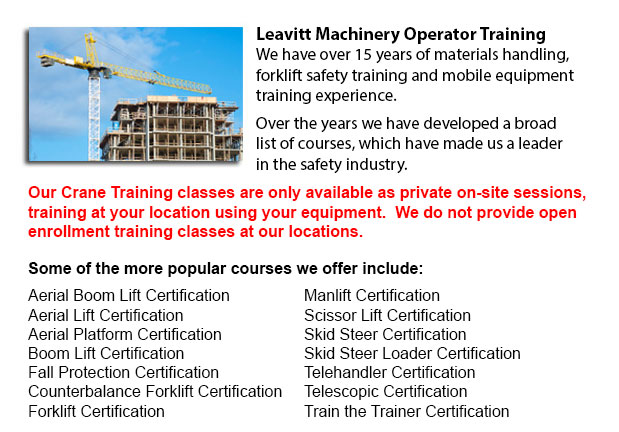
Overhead Crane Safety Training Richmond Hill - Overhead crane safety training equips operators with knowledge and skills about crane safety precautions, accident avoidance, materials handling, and machinery and stock protection. Trainees would learn the kinds of overhead cranes, their capabilities and their uses in various industry settings. For operators who are licensed and trained, the shift in liability moves from the company to the operator. Therefore, the program emphasizes individual operator duties.
The operators in the overhead safety training course would be given instruction about the right ways for doing checks: the pre-shift inspection and the more detailed in-depth inspection. These are important daily routines which must be logged. Properly recorded pre-shift inspections help to protect the business from liability in case of an accident. Pre-shift inspections also prevent expensive repairs, accidents and damage. Operators learn how to designate a specific person to carry out checks, how to maintain the log book and how to report problems.
Each and every inspection must be carried out and documented regularly. Things that should be checked for possible problems, include: increase in the throat opening, hooks for cracks, degree of twist; hoist ropes for corrosion, worn wires, loss of diameter, bird caging and kinks, broken wires, chemical and heat damage; chains for nicks and gouges, corrosion and cracks, twists, distortion, excessive wear, pits, stretching, damage from extreme heat.
The operator would get to learn the right techniques about proper rigging procedures. The process of rigging includes the understanding of the manufacturer's data plate, determining the weight of materials to be lifted, selecting the gear, and utilizing safe practices to secure the load. The program cover in detail the following: safe working loads, and the capacities of chains, ropes, hooks, shackles and slings.
It is vital to understand who could use the cranes at your facility, the job's physical requirements, and operator qualifications needed for permits and specialized job. Safety must be prioritized when using near pedestrian traffic.
The responsibilities included in the safe crane operation includes checking for hydraulic leaks, undertaking visual inspections, testing the controls, checking the safety guards, examining the hook and hoist rope, braking mechanisms and limit switches. Proper reporting procedures are critical. These subject matters are all included in depth in the course.
The program also consists of the proper lifting and moving methods with hoists and cranes. Operators would also learn right hand signals. Training includes how to raise the load, attach the load, abort a lift, set the load and unhook the slings.
The steps involved with moving the load, consists of: starting and stopping procedures, guiding and controlling the load, working with signals and observing working conditions. In the event of power failures, the operator would need to know how to proceed. The program covers methods for removing the slings and lowering the load, parking the crane, storage equipment, and securing an outdoor and indoor crane.
-
Scissor Lift Certification Richmond Hill
Scissor Lift Certification Richmond Hill - Scissor lift platforms are utilized at work sites in order to allow tradespeople - like for example welders, masons and iron workers - to reach their work. Operating a scissor lift platform is usually second... More -
Narrow Aisle Forklift / Order Picker Training / Electric Pallet Jack / Electric Pallet Truck Training in Richmond Hill
A pallet jack is a model of equipment specialized in the transporting of pallets of many dimensions and weights. They might be utilized as an appendage for lift trucks, cranes and other types of heavy machinery or be used on their own. Pallet jacks a... More -
Heavy Equipment Operator Certification Richmond Hill
Heavy Equipment Operator Certification Richmond Hill - The heavy equipment operator is a person who manipulates the controls and drives various kinds of big machinery. Heavy machinery is most frequently used on construction sites in order to deliver... More -
Loader Training Richmond Hill
Loader Training Richmond Hill - Why You Must Finish A Loader Training Course - Individuals wanting work in businesses that use lift trucks must undergo a Loader Training program prior to becoming a certified operator of a lift truck. There are lots o... More -
Manlift Training Richmond Hill
Manlift Training Richmond Hill - Various manlift training programs consist of the review and content of manlift devices. An important part of the course is the practicum where students show their knowledge and practical ability to safely operate a ma... More -
Fall Protection Training in Richmond Hill
There are many injuries at work associated to falling and a lot of fall-related deaths reported every year. Most of these instances could have been prevented with better training, better measures in place, and by correctly equipping personnel before... More -
Wheel Loader Training Richmond Hill
Wheel Loader Training Richmond Hill - Commonly, the various kinds of heavy equipment training are classed into 2 categories of machinery: those which have rubber tires and tracked vehicles. Tracked vehicles consist of items like cranes, bulldozers an... More -
Forklift Certification Schools Richmond Hill
Forklift Certification Schools Richmond Hill - Forklift Certification is mandatory in North America. Hence, forklift training programs are important both for companies and for people seeking jobs in industries as forklift operators. Forklift training... More

Forklift Training Richmond Hill
TOLL FREE: 1-888-254-6157
Richmond Hill, Ontario
forklifttrainingrichmondhill.com
Email Us
About Us


